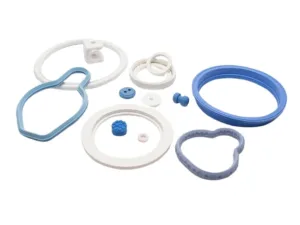Do Silicone O-Rings Stretch?
Introduction
Silicone O-rings are essential sealing components widely used in both industrial and commercial applications due to their exceptional elasticity and weather resistance. Understanding their elasticity and stretching properties is crucial for ensuring proper usage and long-term performance. This article delves into the stretchability of silicone O-rings, exploring their elongation capabilities, the factors influencing their stretch, best practices for installation, and comparisons with other elastomer materials.
1. What Are Silicone O-Rings?
- Definition: Silicone O-rings are sealing elements crafted from silicone rubber, typically in a circular shape, designed to create effective seals between contact surfaces.
- Key Characteristics:
- Heat Resistance: Capable of withstanding high temperatures without degrading.
- Flexibility: Maintains pliability across a wide temperature range.
- Durability: Performs reliably in extreme environmental conditions.
- Applications: Commonly used in the automotive industry, food processing, medical equipment, and other sectors requiring hygienic standards or exposure to extreme temperatures.


2. The Elastic Nature of Silicone Rubber
- Molecular Structure and Elasticity: The unique molecular structure of silicone rubber grants it high elasticity and stretchability. This intrinsic flexibility allows silicone O-rings to deform and conform to sealing surfaces effectively.
- Conforming to Sealing Surfaces: When subjected to force, silicone O-rings can stretch and adapt to the surfaces they are sealing, ensuring a tight and reliable seal.
- Elongation at Break: This is a critical material property that measures the extent to which silicone rubber can be stretched before it breaks. Silicone rubber typically exhibits a high elongation at break, indicating significant stretchability.
3. How Much Can Silicone O-Rings Stretch?
- Typical Elongation Range: Silicone rubber O-rings generally have an elongation percentage ranging from 300% to 700%, depending on the specific formulation.
- Practical Applications:
- Installation Flexibility: The high elongation allows O-rings to be stretched sufficiently to fit snugly into grooves or over flanges during installation.
- Performance Limits: Stretching beyond the design limits can jeopardize the sealing performance or lead to material failure.
- Importance of Stretch Limits: Exceeding the recommended stretching limits can result in seal failure or tearing of the O-ring, underscoring the need for adherence to manufacturer specifications during installation.
4. Factors That Affect the Stretchability of Silicone O-Rings
1. Material Hardness (Durometer)
- Impact of Hardness:
- Higher Durometer: Harder silicone O-rings (with higher durometer ratings) exhibit less stretchability.
- Lower Durometer: Softer O-rings are more flexible and stretchable but are also more susceptible to tearing or damage.
2. Temperature
- High Temperatures: Increase the flexibility of silicone, enhancing its elasticity and stretchability.
- Low Temperatures: Reduce the material’s flexibility, diminishing its ability to stretch.
3. Aging and Wear
- Environmental Exposure: Prolonged exposure to UV light, ozone, or chemicals can degrade silicone O-rings, reducing their elasticity over time and compromising performance.
4. Size and Cross-Section
- Dimensional Factors: The diameter and cross-sectional thickness of an O-ring influence its allowable stretch. Smaller or thinner O-rings tend to stretch more easily but are also more prone to damage.
5. Best Practices for Stretching Silicone O-Rings
- Apply Gradual Force: Use smooth and gradual force during installation to prevent tearing or damaging the O-ring.
- Control Stretch Range: Avoid stretching the O-ring beyond 5%-10% of its inner diameter unless specifically recommended by the manufacturer.
- Use Lubrication When Necessary: Applying lubrication can reduce friction during installation, minimizing the risk of damaging the O-ring.
- Avoid Sharp Edges or Tools: Ensure that installation surfaces and tools are free from sharp edges or burrs that could cut or nick the O-ring.
6. What Happens If Silicone O-Rings Are Overstretched?
- Permanent Deformation: Overstretching can cause the O-ring to lose its original shape and elasticity, preventing it from sealing effectively in future uses.
- Reduced Sealing Efficiency: A loss of elasticity or structural integrity can lead to compromised sealing, increasing the risk of leaks.
- Cracks or Tears: Excessive stretching may result in the formation of cracks or tears, which can lead to complete seal failure under stress.
- Importance of Correct Sizing: Selecting the appropriate O-ring size is critical to avoid relying excessively on stretch, thereby maintaining seal integrity and longevity.
7. Comparing Silicone O-Rings with Other Materials
The table below compares common elastomers used for O-rings, highlighting their elasticity, temperature resistance, chemical resistance, and key characteristics to provide a clear understanding of how silicone stands against other materials.
| Material | Elasticity (Elongation%) | Temperature Range (°C) | Chemical Resistance | Key Characteristics |
|---|---|---|---|---|
| Silicone (Silicone Rubber) | 300% – 700% | -60 to 200 (up to 250) | Excellent, especially against ozone and UV | Maintains flexibility in extreme temperatures, but has lower tear resistance compared to some alternatives |
| Nitrile (NBR) | 200% – 400% | -40 to 100 (short-term up to 120) | Good, particularly against oils and fuels | Cost-effective, excellent oil resistance, but elasticity diminishes at extreme temperatures |
| EPDM | 300% – 500% | -40 to 150 | Good resistance to polar solvents, acids, and bases | Outstanding weather resistance, but less resistant to non-polar solvents like mineral oil and gasoline |
| Viton (FKM) | 150% – 300% | -20 to 200 (up to 250) | Excellent, especially against acids, bases, and fuels | High cost, superior chemical and high-temperature resistance, but slightly less elastic than silicone |
Note: The values provided are typical ranges; actual performance may vary based on specific formulations and manufacturing processes.
8. When to Replace a Silicone O-Ring?
- Visible Cracks, Nicks, or Deformations: Any physical damage to the O-ring necessitates immediate replacement to maintain sealing effectiveness.
- Loss of Elasticity or Sealing Difficulty: If the O-ring struggles to maintain a proper seal or shows signs of reduced flexibility, it should be replaced.
- Regular Inspections: Incorporate routine checks during maintenance to identify and address wear and tear early, ensuring reliable performance.
Conclusion
Silicone O-rings are prized for their high elasticity and temperature resistance, making them indispensable in a variety of sealing applications. A thorough understanding of their stretching properties and adherence to proper installation and maintenance practices can prevent seal failures and material degradation. For optimal performance and longevity, selecting the correct O-ring size and material is essential. When in doubt, consulting with professionals or suppliers can provide the necessary guidance for specific applications and environments.
Call to Action
For more information about silicone O-rings or custom rubber sealing solutions, visit drorubber.com.
You can also contact us via:
- WhatsApp: +0086 15815831911
- WeChat: +0086 13784044874
We are committed to providing you with professional consultation and support





